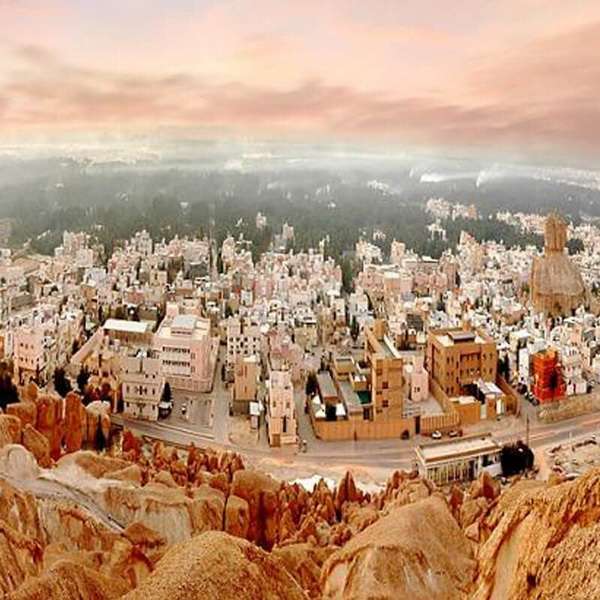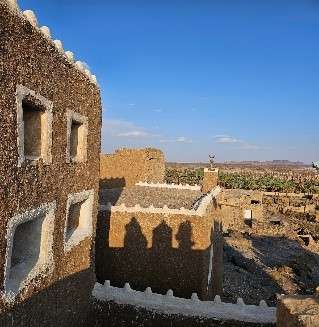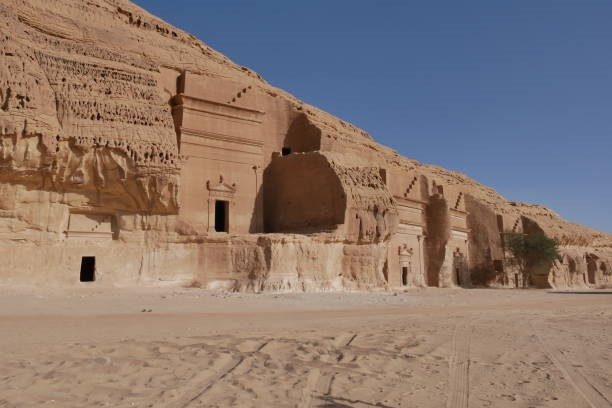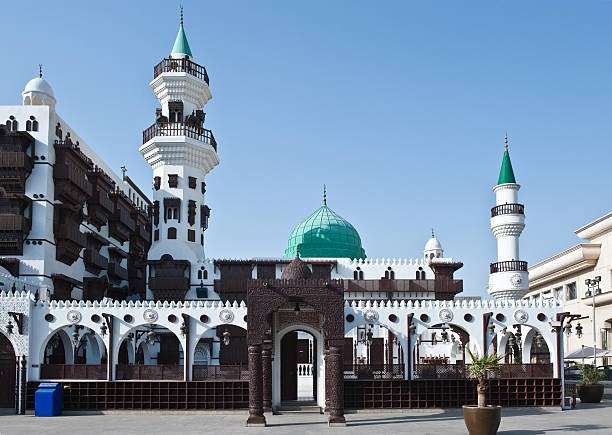9 Days 8 Nights
Daily Tour
Unlimited
___
Take a captivating 9-day journey across Saudi Arabia’s most remarkable regions — from the modern capital of Riyadh to the lush oasis of Hofuf, the historical highlands of Hail, the awe-inspiring sandstone canyons of AlUla, and the cultural seaport of Jeddah.
Travel by high-speed train, comfortable land transfers, and guided tours as you immerse yourself in Saudi Arabia’s rich history, diverse landscapes, and vibrant traditions. Along the way, discover ancient mud villages, rock art, World Heritage sites, and charming old towns.
This tour is perfect for cultural explorers, photographers, and travelers looking for a seamless, in-depth experience of the Kingdom.

Early Morning board the train (Riyadh Station) to Hofuf At 04-40 AM Arrival at 07-00. Upon arrival, begin your tour of the UNESCO-listed oasis region. Visit Qasr Ibrahim, an Ottoman-era fortress, stroll through Souq Al-Qaisariya, this market is a bit like taking a stroll through the pages of a history book, and explore Visit Bayt al-Bay'a, or the House of Allegiance, where the people of al-Ahsa pledged their allegiance to the founding King Abdulaziz bin Abdulrahman al-Saud upon his arrival in the region in 1913. Located in the Al-Rawda neighborhood of Al-Kut, Bayt Al-Bay'ah stands as a symbol of national unity and historical significance in Al Ahsa. Explore detailed exhibits of Al-Ahsa National Museum, it holds the region's heritage across various eras. You can explore the movement of continents, geological times, and the age of the Earth, and compare the region's artifacts with those of the Kingdom as a whole. The museum underscores the significance of the region in agricultural and commercial terms, tracing its importance from ancient times. Visit Al-Ahsa Oasis, a 'UNESCO' World Heritage List, marked the fifth Saudi site to be registered on, Exploring the cool caves of Al Qarah Mountain, it is located twelve km away from al-Hufuf, with a base area of 1,400 ha and an elevation of about 150 ft. Its caves are known for their extreme coolness in the summer and warmth in the winter. Al Qarah Mountain stands out amidst the surrounding flat landscape and lush date palm groves of the oasis. Al Qarah's caves are also rich in various inscriptions and drawings that speak to the region's ancient human presence and trade activities. Overnight stay in Hofuf.

In the morning, explore the desert landscapes drive through sand duanes surrounding Hofuf, including the Yellow Lake. Al Asfar Lake is one of the largest bodies of water in the Arabian Gulf region, formed by the accumulation of heavy rainwater. The lake stretches about twenty-five km in length and is surrounded by desert plants and grasses, it looks like a view from a postcard, you can enjoy a peaceful retreat to this tourist spot and marvel at the beauty of nature. Early afternoon board the train (Hofuf Railway Station) to Riyadh At 01-41 PM . Upon arrival at 04:01 PM begin your discovery of the capital, stroll through Diriyah’s At-Turaif District, Diriyah is one of the largest mud cities in the world. The foundations and columns of all its structures were built of stones, while its walls and partitions were built of mud and tamarisk trunks and branches. It is also recorded in the UNESCO World Heritage List. and end with breathtaking views from the Kingdom Towers, A defining feature is the Sky bridge, offering stunning panoramic views of the city. Overnight in Riyadh

Our day begins with a journey into the heart of old Riyadh. Wander the narrow lanes of AlDirah Neighborhood, featuring a number of houses, mosques, streets, and squares built according to the urban style of the city. Shop at Souk Al-Zal, is one of Riyadh’s oldest markets, known for its variety of antiques, carpets, vintage items, and traditional goods. Next, step into history at Al Masmak Palace, the mud-brick fortress tied to the kingdom’s unification. Afterwards, immerse yourself in the cultural treasures of the Saudi National Museum, a world-class showcase of Arabia’s history, Islam, and heritage, then visit the elegant Murabba Palace, was the first palace built for King Abdulaziz Bin Abdulrahman Al Saud, the Founder of the Kingdom of Saudi Arabia. Evening flight to Hail. Overnight in Hail.

Morning visits to Qashla Castle, It was constructed during the rule of the Founding King Abdulaziz Bin Abdulrahman Al Saud in 1941. See the A'arif Fort, is the oldest historical building in the city of Hail. During the Saudi rule, the Fort was used for the sighting of the moon and firing the Iftaar cannon in Ramadan. The Hail Regional Museum, whose identity is influenced by the Hail urban and heritage identity, is home to antiquities and its other historical items from the governorate, continue to Al-Ha'it once a historic stronghold, visiting Fadk Historical village (Al-Ha'it) is located on a plateau covered with volcanic stones, which, when removed, reveal fertile agricultural soil underneath. Fadak is its ancient name and is currently called Al-Ha'it. In recent centuries, its name changed from Fadak to Al-Ha'it due to the wall that surrounds it on all sides. Continue to AlUla. Overnight stay in AlUla.

Explore the Hegra (UNESCO World Heritage Site) Hegra or Hijr is a World Heritage Site and a Saudi touristic and historic monument. It is located in AlUla governorate, affiliated with Madinah, northwest of the Kingdom of Saudi Arabia. Hegra, which was known for a long time as Mada’in Salih, consists of ruins that have combined various historical eras, including Nabataean, Lihyanite, and Islamic. Its most famous landmarks are the historical tombs carved on the facades of sandstone rocks. Explore Lion Tombs of Dadan, nestled within the breathtaking landscapes of AlUla, Saudi Arabia, Dadan is an archaeological treasure that offers visitors a glimpse into the rich history and culture of ancient civilizations. From its intricately carved Lion Tombs to its strategic role in ancient trade routes, Dadan promises a captivating journey through time. End the day at the iconic Elephant Rock, The Elephant Rock (Jabal AlFil) is one of the world’s most popular rocks formations and the highlight of the region of Al Ula, it is also one of the geological wonders of al-Ula and a tourist attraction Visiting the rock at night is advantageous to avoid the hot weather during the day, with sunken sofa areas and the option to light a fire; you can sit and enjoy the music, coffee, and mountains. End at the Elephant Rock. return to hotel for Overnight.

Journey south to Khaybar to visit its forts and volcanic fields,
Khaybar is rich in many tourist attractions and archaeological sites. It is home to several archaeological sites, forts, and historical castles, some of which date back to pre-Islamic eras. Then continue through Madinah, officially al-Madinah al-Munawwarah, also known as Taybah known in pre-Islamic times as Yathrib, is the capital and administrative center of Medina Province in the Hejaz region of western Saudi Arabia. It is one of the oldest and most important places in Islamic history. Board the train from Madinah to Jeddah for overnight stay.

Spend the day discovering Jeddah’s UNESCO-listed treasures. Start at the lively Fish Market, a window into daily life by the sea, where fishermen bring in their catch of the day. Continue to the Tayebat Museum stands as one of Jeddah’s most prominent private cultural landmarks, showcasing the depth of Saudi history and the richness of its diverse civilizations, then step into the historic lanes of Al-Balad, where coral-stone houses and carved wooden balconies recall centuries of trade. Visit Souk Al-Alawi, One of the largest markets in Al Balad. Souq Al Alawi is a labyrinth of narrow streets with shops selling a variety of goods. Explore Nassif House, is a treasure trove of history nestled in the heart of Al-Balad, the historic district of Jeddah, built during the late 19th century. This iconic museum in Jeddah showcases the city’s rich cultural heritage and a great site for anyone eager to explore Saudi Arabia’s vibrant past. And pause at the ancient Al Shafi’i Mosque, which is one of the oldest mosques in Jeddah, then visiting the striking Floating Mosque. In the evening, admire the world’s tallest King Fahd Fountain and take a leisurely stroll along the Corniche. Overnight in Jeddah.
Most travelers require a visa. You can apply for a tourist eVisa online, which is available for citizens of many countries.
Yes, Saudi Arabia is generally safe for tourists. Follow local laws and customs, and stay aware of your surroundings.
Modest clothing is recommended. Women are not required to wear an abaya but should dress conservatively. Men should avoid sleeveless tops and shorts in public.
Major credit cards are widely accepted, especially in cities. However, it's good to carry some cash for small shops and rural areas.
No. The sale, purchase, and consumption of alcohol are strictly prohibited.
Arabic is the official language. English is commonly spoken in tourist areas, hotels, and by younger generations.
The currency is Saudi Riyal (SAR). ATMs are widely available.
Yes. As of recent regulations, unmarried foreign couples are allowed to stay in the same hotel room.
You can take photos of landscapes and tourist attractions, but avoid photographing government buildings or locals without permission.
October to March is ideal due to cooler weather, especially for outdoor activities and sightseeing.
Leave a review